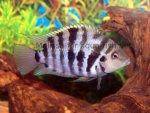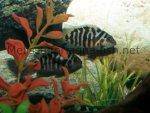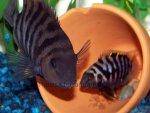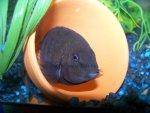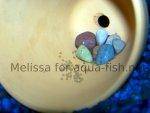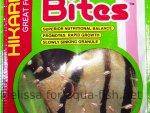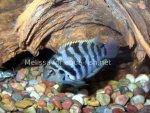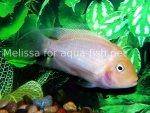The Complete Guide to Convict Cichlid Care, Breeding, and Tips
Quick navigation
Brief Description
This page gives an easy-to-understand guide on caring for Convict Cichlids. You’ll find FAQs, pictures, and more helpful details. Feel free to share your experiences using the form at the bottom - whether you have a question or a tip, we’d love to hear about your Convicts! Also, make sure to check out this page: Profile of Convict Cichlid, which also has user comments!
Introduction
The Archocentrus nigrofasciatus, commonly known as the “convict” or “zebra” cichlid, gets its name from its black stripes, resembling a classic prison uniform. This fish is native to Central American waters in countries like Guatemala, El Salvador, Costa Rica, Honduras, and Panama, where water temperatures range from 69 - 84°F (~20 - 29°C). Convicts are hardy and adaptable, thriving as long as water conditions are stable. They are omnivorous and not fussy about food, consuming anything that fits in their mouths, from flake and pellet foods to small fish, crustaceans, and bloodworms. They especially enjoy frozen beef hearts. Males can grow up to 6 inches (~15 cm), slightly larger than females. Be aware that this species is highly aggressive, often challenging fish twice their size, particularly during breeding.
Sexual Dimorphism
Convict cichlids are known for their prolific breeding habits, often spawning in any available space. Identifying males and females is quite simple due to their distinct differences. Females are typically smaller, rounder, and more colorful than males. They display bright orange patches on their bellies, with light grey stripes that contrast sharply against their black bands. These colors become even more vibrant when they're ready to spawn. Males, on the other hand, are usually darker grey with black stripes, have pointier pectoral, dorsal, and anal fins, and are generally larger than females. Mature males often develop a vestigial lump on their heads, similar to the flowerhorn cichlid, although the purpose of this hump is unknown. When happy and comfortable, both males and females may exhibit iridescent blues, greens, and yellows on their fins. To keep convicts healthy and ready to spawn, provide clean water and a balanced cichlid diet.
Breeding
Once a male and a female convict cichlid have bonded, they quickly form a monogamous pair and begin reproducing. Convict cichlids reach reproductive maturity at a young age, with spawning possible when they are less than 2 inches (5.08 cm) long and as young as 16 weeks. The courtship process is brief, after which they select a location to claim as their breeding site, typically in a cave or under rocks or logs. In captivity, a flower pot is often an ideal choice for this purpose.
There was an instance where two pairs of convicts did not spawn for about a month. After a flower pot was introduced into the tank, eggs were observed scattered across the bottom the very next day. While this may have been coincidental, it is a commonly observed scenario. The new parents became so defensive of their eggs that the decision was made to relocate the other pair to a different tank to give the reproducing couple some privacy. Despite this, the pair continued to hide their young under piles of gravel, with the male tearing out every plant in the tank while digging his protective holes.
By closely observing a pair of convict cichlids, it becomes evident when they are ready to spawn. The female's colors will deepen as she prepares to lay her eggs, and the male will stand guard, aggressively chasing away any intruders. A single pair of convicts can dominate the entire aquarium in their efforts to care for their brood. Other fish often end up cowering on one side of the tank, as convicts are known for being excellent and highly protective parents. They will hide their young if they perceive any threat, demonstrating impressive parenting behavior for fish.
After the eggs are laid and fertilized, the female takes a position above them, continuously fanning the eggs with her fins to ensure proper oxygenation. The eggs typically hatch in less than a week, and about three days later, the fry absorb their yolk sacs and become free swimmers. At this stage, they are ready to start eating fry food. Suitable fry foods include newly hatched brine shrimp, live microworms, finely ground fish flakes, or commercially available powdered food. It is essential to provide the fry with a nutritious diet rich in protein, as the quality of their diet during this early stage will significantly impact their development into healthy adult cichlids.
Varieties of Convict Cichlids: The Pink, White, and Gold Convicts
The convict cichlid can also be found in a leucistic strain known as the pink convict, white convict, or gold convict. Leucism is a condition characterized by reduced pigmentation in animals. Unlike albinism, it is caused by a reduction in all types of skin pigment, not just melanin. This strain of convict is not as easy to breed as the common zebra-striped version, but they are reproduced for the aquarist industry, and their breeding habits remain the same. The females are whitish-pink with red splotches on their bellies, while the males are plain whitish-pink.
Convict fish are fascinating to keep due to their active and reproductive nature. Their adaptability makes them relatively easy to care for, and their aggressive behavior paired with their instinctive parenting skills is a source of enjoyment for many aquarists. Overall, convicts are excellent fish for all aquarists, whether experienced or just starting out.
Frequently Asked Questions
As part of our site updates, content from aqua-fish.net/answers was merged with related articles, and the following answers were moved here on March 25th, 2011. You're encouraged to submit your own questions as well; simply use the form at the bottom of this page!
-
How can you tell when convict cichlids are ready to breed?
Answer: Convict cichlids show readiness to breed when the female’s belly colors intensify, becoming more vibrant. Additionally, the pair will engage in a mating dance, which includes shaking their heads at each other.





